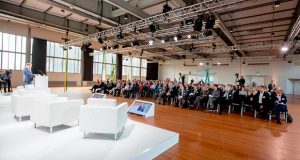A new non-fiction book on the history of mining in Germany has recently been published (currently only available in German). Authors Lars Bluma, Michael Farrenkopf and Stefan Przigoda all work at the German Mining Museum in Bochum, the world’s leading museum of the mining industry.
The first, introductory chapter focuses on mining in ancient civilisations, starting from flint mines in the neolithic era, and taking us through the bronze age and iron age to the time of the Roman Empire. A contribution from guest author Prof. Thomas Kirnbauer from the TH Georg Agricola University of Applied Sciences in Bochum then guides us through the geology and natural foundations of ore, coal, and salt deposits in Germany, before the main authors return with a description of the historical aspects of pre-industrial mining and explore the various myths and legends that have surrounded the mining industry since time immemorial.
This is followed by substantial chapters on the extraction of the different natural resources, their usage, the development of mining technology and health and safety, as well as the significance of mining as a basis for industrialisation and technological progress. Mining companies and miners’ organisations are also introduced – miners’ insurance associations, miner’s guilds, mining clubs, unions, and associations – along with their cultural traditions, as well as the consequences mining has on the environment. On this subject, the authors also adopt a global perspective including the opportunities and risks facing, e. g., newly -industrialised and developing countries – not least those emerging from conflicts over certain raw materials and from efforts to develop deep sea mining.
The final chapter is dedicated to the future perspectives of mining in Germany, which will not end completely with the closure of the final coal mines in December this year. New rumours of discoveries, e. g., in the Ore Mountains, are testament to this. However, the authors approach this subject with the requisite caution and a warning of the uncertainty of future global developments. It should be mentioned here that the book is written in a complex register which provides many key words to explain less common, but still very interesting aspects.
The book includes many illustrations and old photos and provides a highly informative overview of the history of mining from its origins to the present day, as well as the work of miners, their culture and their traditions. It is aimed both at a broad, general interest readership with no specialist mining knowledge, and at mining historians. For this reason, it should not really be compared with other works on mining history, such as the four-volume handbook “Geschichte des deutschen Bergbaus” on the history of German mining. It is an intriguing appetizer for anyone who may want to explore the fascinating history of the mining industry in more detail.
Andreas-Peter Sitte


